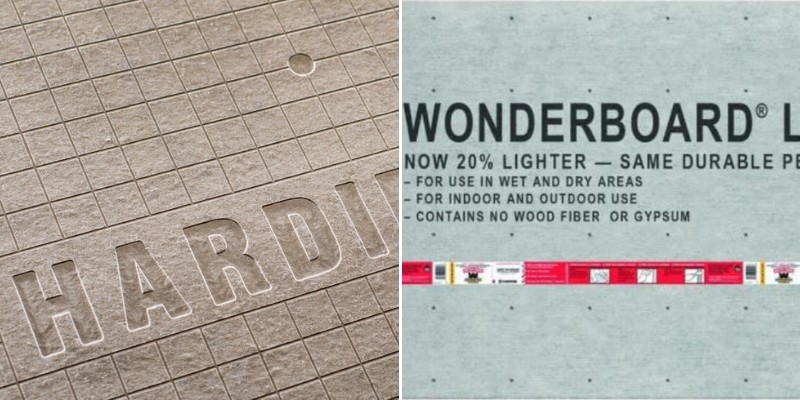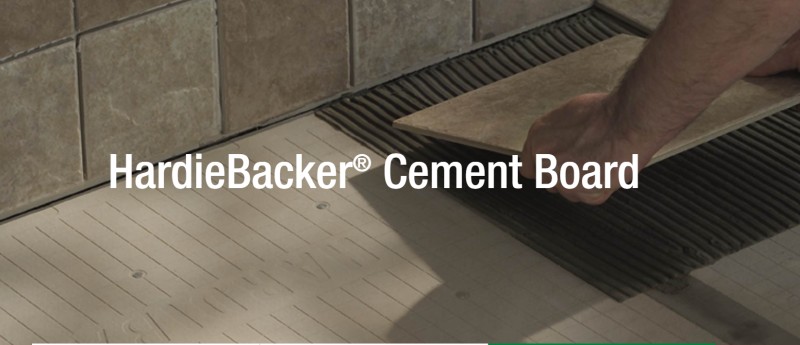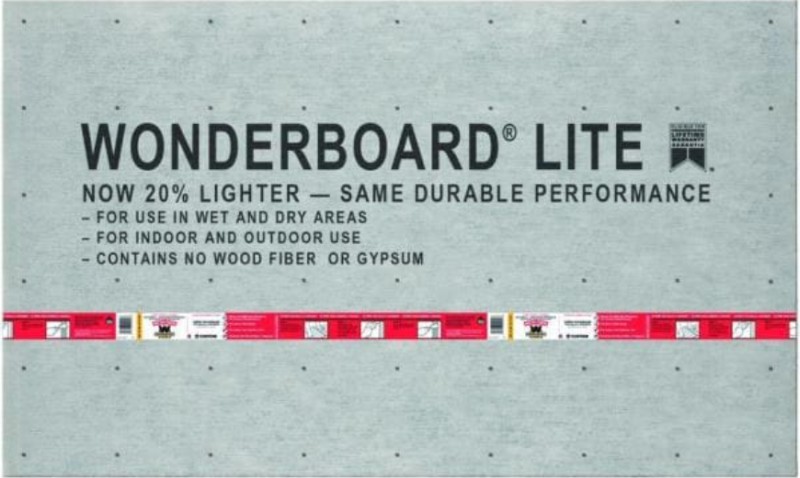Cement board, or backerboard, is a useful helper in your DIY projects. Backerboard is used as the foundation for flooring, walls, or other installation projects.

Cement Backer Boards protect existing surfaces while providing a more stable foundation for subsequent materials such as tiles.
They are more stable and resistant to environmental damage, which sets them apart from other materials such as wood or drywall.
HardieBacker and WonderBoard are two of the most common brands when it comes to cement backerboards.
They did not become popular without merit. Both HardieBacker and WonderBoard make quality products that provide a good foundation for most construction projects.
However, they have slight differences that could make or break your construction project.
Here is your guide to choosing HardieBacker compared to WonderBoard when you are planning the remodeling of your bathroom.
Read on for an extensive guide to their relative merits and drawbacks as well as a detailed explanation of their respective materials, characteristics, and more.
What Is HardieBacker Backerboard?
HardieBacker cement board is made mainly of Portland cement, the most common type of cement for general usage, and sand.

However, its additional materials are what set this brand of board apart from the competition. HardieBacker also contains cellulose fibers and a MoldBlock additive.
One of the unique properties of HardieBacker is its water-resistant properties. The HardieBacker HydroDefense board is waterproof, making it ideal for use in wet areas such as the bathroom. Even regular HardieBacker boards are water and moisture-resistant as well as mold repellent.
HardieBacker’s cement boards also stand out because of their easy usage. Unlike other backerboards such as Durock, HardieBacker is lighter and more flexible.
It is also easier to use because of the lack of mesh and a special grid pattern that makes it easier for you or your contractor to cut out the ideal size that you need.
Finally, HardieBacker is compatible with many surfaces. It is relatively gentle compared to other backerboards, which means that you can use it with sensitive materials such as vinyl and enamel without damaging them. HardieBacker cement boards also have a smoother surface that absorbs paint or other decorations.
What Is WonderBoard Lite Backerboard?
WonderBoard Lite backerboard is made by the WonderBoard company. It is made of a fiberglass and cement formula that is reinforced by mesh. It does not have fiber or gypsum, which impacts the durability of backerboards.

One of WonderBoard’s Lite defining characteristics is its 20% lighter fiberglass which makes it easier to work with.
Due to its unique formula, it has high flexular strength which means that it is also suited for curved surfaces than other cement board brands such as Durock.
However, this cement backerboard does not compromise strength for flexibility and it is also highly durable.
WonderBoard’s backerboards are also compatible with multiple surface materials such as tile, stone, slate, and thin brick. That makes it a good choice for multiple applications, from walls to ceilings and any size of installation in between.
WonderBoard backerboards are also water-resistant, which is an important quality you are looking for when remodeling your bathroom.
HardieBacker Vs WonderBoard: A Comparison
The biggest difference between HardieBacker and WonderBoard Lite is in their composition. HardieBacker is made of a blend of cement, sand, and cellulose fibers, while WonderBoard is made of a cement mixture reinforced by mesh.
This difference in materials affects their other properties. HardieBacker is lighter and easier to use than WonderBoard because it is not a pure cement backerboard.
Both HardieBacker and WonderBoard claim some degrees of water resistance. However, WonderBoard’s average backerboards are more resistant than HardieBacker’s regular line, excluding the HydroDefense backerboards. WonderBoard is approved for usage outdoors while HardieBacker is not.
While the price varies according to store, thickness, and other factors, a 3ft x 5ft tile of HardieBacker backerboard that is ¼ inch thick costs on average about $12.
A WonderBoard tile of the same size costs about $10, which is $2 less expensive. On a large project, those differences add up.
Both HardieBacker and WonderBoard are great cement backerboards and you will successfully remodel your bathroom with either one.
However, they are suited toward different projects. If you are covering a large surface, such as your walls or floor, WonderBoard is better because it is stronger and less expensive.
For smaller areas, such as corners of the bathroom or the surface of a vanity, HardieBacker is a better choice because it is easier to use and less prone to breakage when you are cutting it into smaller pieces.
HardieBacker is also more compatible with sensitive materials such as vinyl and enamel, while WonderBoard could damage your tub or installation.
Pros and Cons of HardieBacker
One of HardieBacker’s major advantages is that it is relatively easy to use. It is made of a mixture of cellulose fibers and cement instead of pure cement, so it is lighter than WonderBoard, which is made of a mostly cement formula.
That gives HardieBacker the advantage, particularly when it comes to DIY installation work or if you have a smaller contracting team.
HardieBacker is also easier to cut and shape than WonderBoard. WonderBoard’s mesh makes it difficult to cut this board, while HardieBacker’s smooth cutting experience is made even easier by the pre-cut grid pattern that you just have to follow when cutting.
It is also less brittle, while pure cement board is prone to snapping, particularly when you are cutting it into thin pieces.
However, HardieBacker is slightly less durable than WonderBoard. For example, it is not approved for outside usage.
While this may not be an issue if you are only remodeling your bathroom, if you are also planning some outdoor projects, it would make no sense to have to go out and buy more backerboard from a different brand.
Some users have also reported that they had trouble using HardieBacker for their walls. It requires special stud spacing for installation, which is not compatible with all walls and sometimes has trouble sticking to thinset.
Pros and Cons of WonderBoard Lite
One of the advantages of WonderBoard Lite over HardieBacker is its reliability. It is more similar to traditional cement backerboards in its material, so it is slightly stronger and more durable than HardieBoard.
It is also more straightforward to use than HardieBoard, which has unique specifications regarding stud spacing, wetting the material, and more. Particularly for experienced contractors that may be used to cement backerboards, WonderBoard is a clear choice.
Unlike other cement backerboards, WonderBoard is not completely stiff. It is flexible, making it a good choice for curved surfaces.
WonderBoard is also safer for wet areas than HardieBacker. While HardieBacker has a waterproof line called HardieBacker HydroDefense, most of its products are only water-resistant, not fully waterproof, and need to be used with additional waterproof sealants. All of WonderBoard’s products are fully water-resistant.
However, WonderBoard is much harder to use than HardieBoard. It is heavier and harder to cut. It is also more prone to shattering, particularly when you are attempting to cut out smaller pieces.
Choosing HardieBacker or WonderBoard
After reading this article, hopefully, you are feeling more informed in your choice of cement backerboards.
HardieBacker and WonderBoard serve similar purposes, but their different materials mean that they are suited toward different projects.
The lighter HardieBacker works best for small projects or situations where you have to work solo, while the heavy but durable WonderBoard provides a good foundation for your walls and flooring.
Related Posts
- Comparison of HardieBacker Cement Board vs Plywood For Tiling Projects
- 6 Great Alternatives to HardieBacker Cement Board
- Comparison of WonderBoard vs GoBoard Used as Tile Backer Boards
- How Much Does it Cost to Furnish a House – Living Room,Bedroom,Kitchen etc
- 5 Benefits of Spray Foam Insulation During Summer
- Here are Some Plumbing Installation Tips For your New Home
From everything I’ve read and in making a comparison of the two, Hardibacker is heavier than WonderBoard Lite. Other than that I enjoyed your article. But for my project which will be outdoors, I will be choosing WonderBoard Lite. I’ll just have to be careful when making my cuts. This is my first project so I have been doing a lot of research.
Excellent, very informative, thank U ..